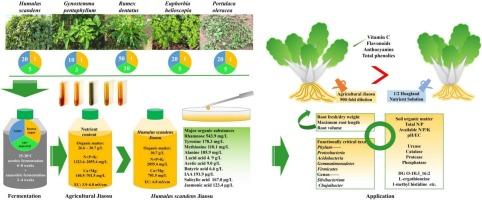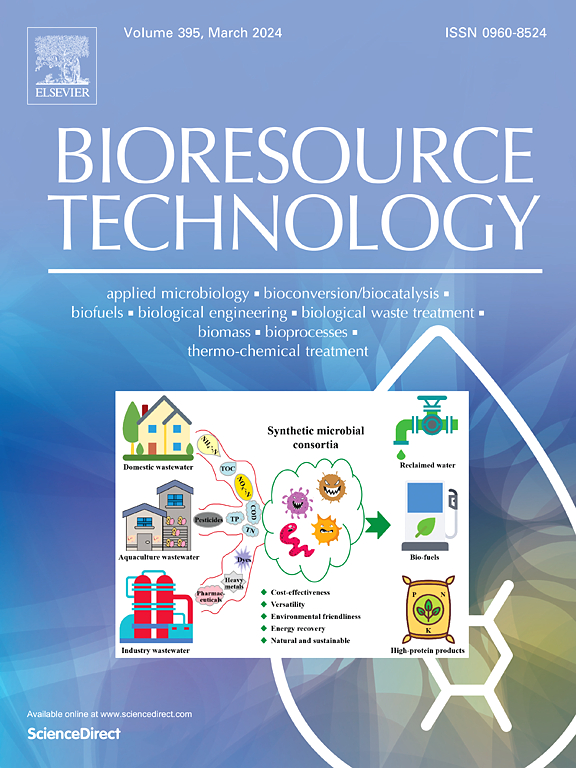绿色农业生产中利用野生植物资源的新途径——以葎草为原料制备农用胶素为例
IF 9
1区 环境科学与生态学
Q1 AGRICULTURAL ENGINEERING
引用次数: 0
摘要
野生植物资源在绿色农业生产中具有巨大潜力,但利用途径有限。农业胶素作为一种生态友好型技术,为促进农业可持续发展提供了一条很有前景的途径。本研究探讨了从野生植物中制备AJ的可行性。葎草(humulus scandens)、绞股蓝(Gynostemma pentaphyllum)、齿牛(Rumex dentatus)、大戟(Euphorbia helioscopia)和马齿苋(Portulaca oleraceae)等5种植物加工成的AJ具有丰富的有机质和矿质营养成分。以葎草AJ为例,AJ溶液中含有鼠李糖(543.9 mg/L)、酪氨酸(178.3 mg/L)、甲硫氨酸(110.1 mg/L)、丙氨酸(105.9 mg/L)、乙酸(9.0 g/L)、丁酸(6.6 g/L)、乳酸(4.9 g/L)等丰富的有机物质,以及生长素(191.9 μg/L)、水杨酸(167.0 μg/L)、茉莉酸(123.4 μg/L)等植物激素。与1/2 Hoagland solution (CK)对照试验表明,葎草AJ对小白菜生长和营养品质的影响相当。值得注意的是,与对照相比,AJ处理促进了根系发育,增加了维生素C、类黄酮、花青素和总酚类物质。机理分析表明,施用AJ可通过提高土壤有机质、矿质养分和酶活性,改变土壤次生代谢物和重组微生物群落来促进土壤肥力的培养。综合分析发现22个环境因子对土壤微生物群有显著影响;AJ能直接或间接改善土壤生态条件,促进小白菜根系发育和品质形成。该研究表明,AJ技术可以有效地将野生植物(包括不受欢迎的物种)转化为有价值的农业投入物。农业农业通过重构土壤微生态系统,促进农业可持续发展。本文章由计算机程序翻译,如有差异,请以英文原文为准。

A novel approach for utilizing wild plant resources in green agricultural production: A case study of preparing agricultural Jiaosu from Humulus scandens
Wild plant resources possess significant potential for green agricultural production, yet their utilization pathways remain limited. As an eco-friendly technology, agricultural Jiaosu (AJ) offers a promising approach to enhance sustainable agriculture. This study investigated the feasibility of preparing AJ from wild plants. Five species—Humulus scandens, Gynostemma pentaphyllum, Rumex dentatus, Euphorbia helioscopia, and Portulaca oleracea—were processed into AJ, which exhibited abundant organic matter and mineral nutrients. Using Humulus scandens AJ as a representative example, the AJ solution contained rich organic substances, including rhamnose (543.9 mg/L), tyrosine (178.3 mg/L), methionine (110.1 mg/L), alanine (105.9 mg/L), acetic acid (9.0 g/L), butyric acid (6.6 g/L), lactic acid (4.9 g/L), along with phytohormones such as auxin (191.9 μg/L), salicylic acid (167.0 μg/L), and jasmonic acid (123.4 μg/L). Comparative trials with 1/2 Hoagland solution (CK) demonstrated that Humulus scandens AJ application achieved comparable effects on pakchoi growth and nutritional quality. Notably, AJ treatment enhanced root development and increased vitamin C, flavonoids, anthocyanins, and total phenolics compared to the control. Mechanistic analysis indicated that AJ application contributed to cultivate soil fertility by elevating soil organic matter, mineral nutrient, and enzymatic activities, altering soil secondary metabolites and restructuring microbial communities. Comprehensive analysis identified 22 environmental factors significantly influencing soil microbiota; AJ could directly or indirectly improve soil ecological conditions to enhance pakchoi root development and quality formation. This study demonstrated that AJ technology could effectively convert wild plants, including undesirable species, into valuable agricultural inputs. By restructuring soil microecosystems, AJ promoted sustainable agricultural development.
求助全文
通过发布文献求助,成功后即可免费获取论文全文。
去求助
来源期刊

Bioresource Technology
工程技术-能源与燃料
CiteScore
20.80
自引率
19.30%
发文量
2013
审稿时长
12 days
期刊介绍:
Bioresource Technology publishes original articles, review articles, case studies, and short communications covering the fundamentals, applications, and management of bioresource technology. The journal seeks to advance and disseminate knowledge across various areas related to biomass, biological waste treatment, bioenergy, biotransformations, bioresource systems analysis, and associated conversion or production technologies.
Topics include:
• Biofuels: liquid and gaseous biofuels production, modeling and economics
• Bioprocesses and bioproducts: biocatalysis and fermentations
• Biomass and feedstocks utilization: bioconversion of agro-industrial residues
• Environmental protection: biological waste treatment
• Thermochemical conversion of biomass: combustion, pyrolysis, gasification, catalysis.
 求助内容:
求助内容: 应助结果提醒方式:
应助结果提醒方式:


